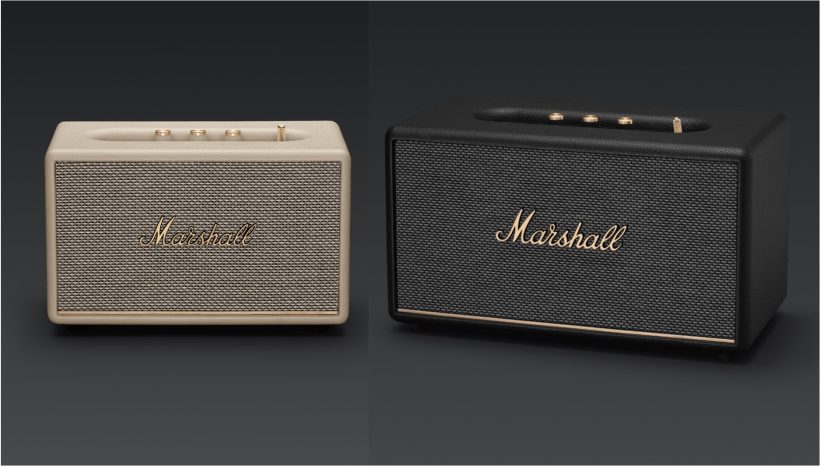The Marshall Acton III and Stanmore III are some of the loudest Marshall speakers ever developed with a classic vintage amp design and bass reflex ports for deeper bass response. Comparatively, the only difference between the Stanmore III and the Acton III is that the Stanmore III is a much larger speaker (with a dimensions of 13.8” x 8” x 7.4” as compared to the Acton III’s 10.2” x 6.7” x 5.9” dimensions) and delivers slightly more power output (80W RMS) as compared to the Acton III speaker (which delivers 60W RMS) of power. The Stanmore III is comparatively louder and has a more bass-leaning sound signature, while we felt from our tests that the Acton III delivered a more neutral sound signature with an emphasis on clarity and on the highs.
Both speakers feature a 2-way channel stereo design and comes equipped with 3 Class D amplifiers for high performance music and deeper bass response. Both speakers also comes with bass reflex ports which help to emphasize the lower bass beats – both speakers have virtually the same frequency range from 45 Hz to 20 kHz and can handle the lows and mid-range frequencies really well. The Stanmore III however can deliver louder sound performance with an SPL up to 97 dB, while the Acton III can deliver up to 95 dB of SPL. Both speakers require AC input power from 100 to 240 VAC.
Read more: The 10 Best Marshall Speakers Ranked
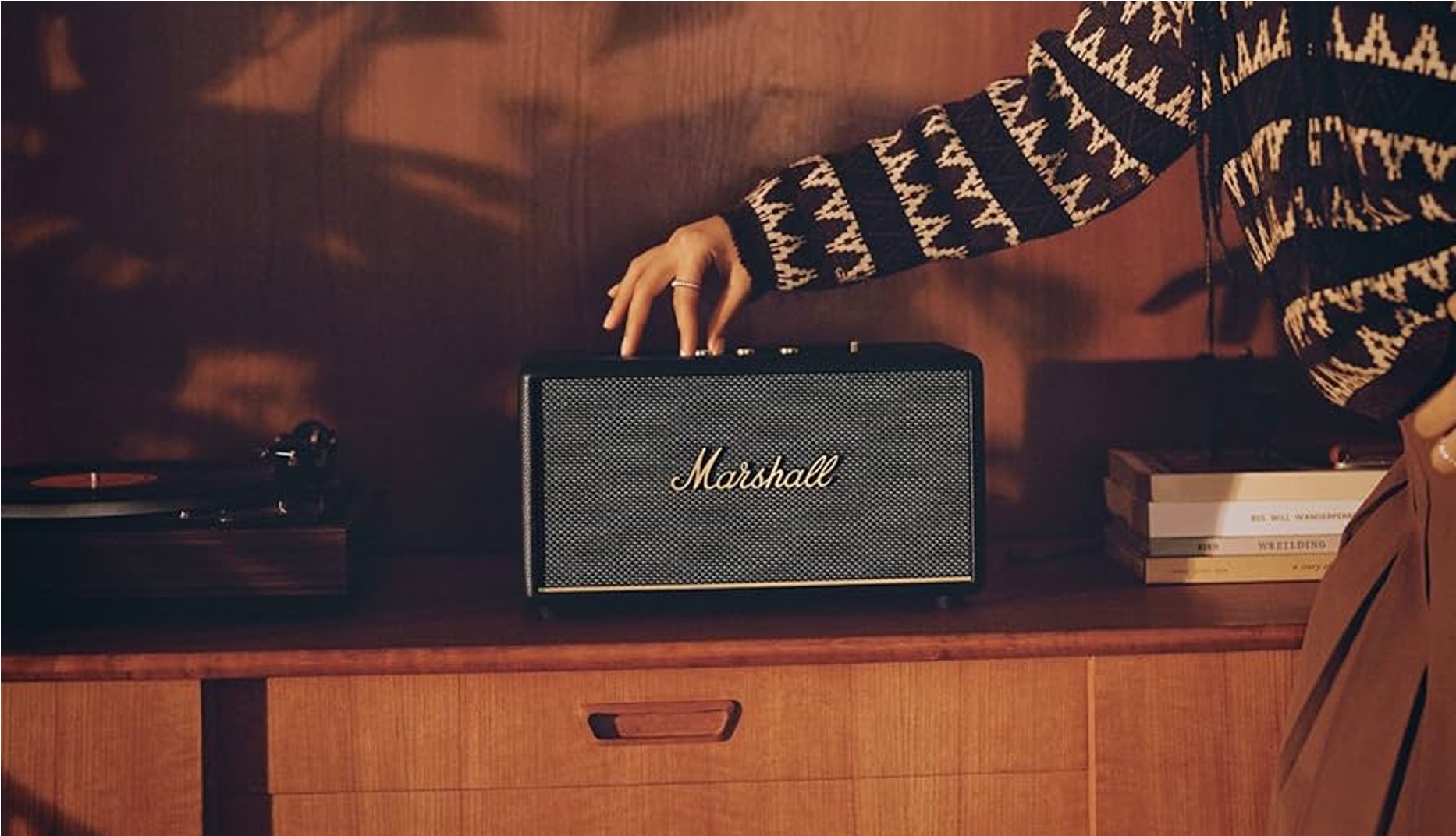
Comparing the Specs
| Specification | Marshall Acton III | Marshall Stanmore III |
|---|---|---|
| Launch Year | 2022 | 2022 |
| Frequency Range | 45 – 20,000 Hz | 45 – 20,000 Hz |
| Maximum Sound Pressure Level | 95 dB @ 1 m | 97 dB @ 1 m |
| Power Amplifiers | One 30 Watt Class D (woofer), Two 15 Watt Class D (tweeters) | One 50 Watt Class D (woofer), Two 15 Watt Class D (tweeters) |
| Wattage | 60W | 80W |
| Controls and Connectivity | Bluetooth 5.2, 3.5 mm Input, Marshall Bluetooth App, No Wi-Fi | Bluetooth 5.2, 3.5 mm Input, RCA Input, Marshall Bluetooth App, No Wi-Fi |
| Dimensions | 260 x 170 x 150 mm | 350 x 203 x 188 mm |
| Weight | 2.85 kg | 4.25 kg |
| Colorways | Black, Cream, Brown | Black, Cream, Brown |
| Additional Features | Adjustable bass and treble controls, No water resistance | Adjustable bass and treble controls, No water resistance |
The Stanmore III has a higher maximum sound pressure level and more powerful amplification for the woofer compared to the Acton III. It also has an additional RCA input for connectivity. The Stanmore III is larger and heavier (4.25kg) while the Acton III’s smaller size enhances its portability. Both models offer a wide frequency range, ensuring a rich and detailed sound experience. In terms of power output, the Stanmore III has more power (80W) compared to the Acton III’s 60W.
Sound Comparison
In terms of sound performance, the Marshall Acton III delivers much more neutral sound quality as compared with the Stanmore III – vocals and highs sounded much cleaner and flat, and you can really hear all the details in the music which you might not have noticed before. If you are a producer that needs to hear your music in a very neutral and detailed way, the Marshall Acton III will definitely allow you to hear things in the music which you might not have heard before – we really liked how the Acton III separated frequencies and instruments, allowing you to get a good sense of separation and soundstage while using this speaker. The bass on this speaker also pumps out decent and tight bass performance that doesn’t overwhelm or sound muddy into the midrange frequencies; it stays where it should be as bass and makes the entire listening experience really nice and consistently clean. The bass is very clean and the treble ranges feel crisp and very clear; it feels as though you are listening to
Read also: Marshall Stanmore 3 vs Stanmore 2: Is it worth the upgrade?
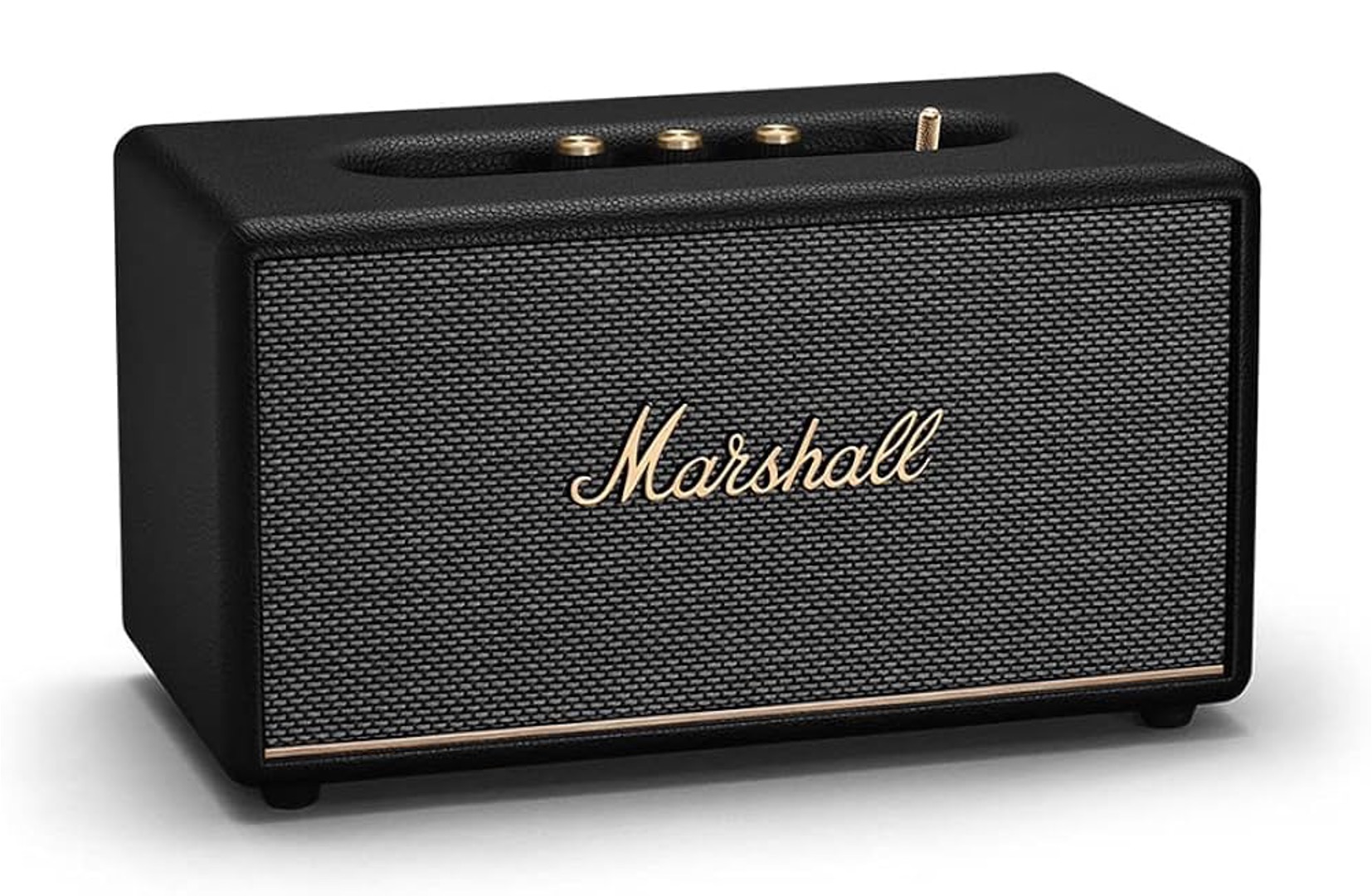
By contrast, the Marshall Stanmore III clearly has a more bass-leaning sound signature which emphasizes the low-end beats much more, making them great for blasting EDM, rock or hip-hop music genres where the bass feels much bigger and engaging. Songs such as “Senorita” by Shawn Mendes sounded absolutely punchy with very nice bass beats, and the speaker also gets considerably louder than the Acton III without any hint of distortion.
We also tested both speakers on jazz songs such as Tony Bennett’s “For Once In My Life” and “I left my heart in San Francisco” and we found that the Stanmore III delivers much deeper bass and engaging vocals as compared to the Acton III. The Acton III speaker by contrast, sounds much more neutral and balanced, and does not have as much as a bass “kick” to the sound. In terms of overall soundstage, both the Stanmore III and Acton III are equally comparable and deliver really nice separation between the vocals and the instruments – you can almost hear where the vocalist is standing on stage. Both speakers are also great at picking out details in the music which you might not have noticed before, such as the breathing of vocalists in between pauses, and the subtle strokes of piano keys.
The soundstage that both speakers deliver is excellent and you can really hear the separation between the right and left stereo channels. Music instruments sound really crisp and well defined, and you can even pick out where each individual instrument note is coming from and hear precise details in the soundtrack that you might not have noticed before.
Having said that, the Marshall Stanmore III gets much louder than the Acton III, and does not distort or cut out any frequencies at higher volume levels – the highs and midranges remain consistently clean and clear. The bass is superb and the treble ranges are warmer and well-defined on the Stanmore III. We would say that the Stanmore III sounds more “vintage” and engaging with a clearly bass-leaning sound signature, while the Acton III feels more like a studio monitor with an emphasis on clarity and vocals with a neutral frequency response.
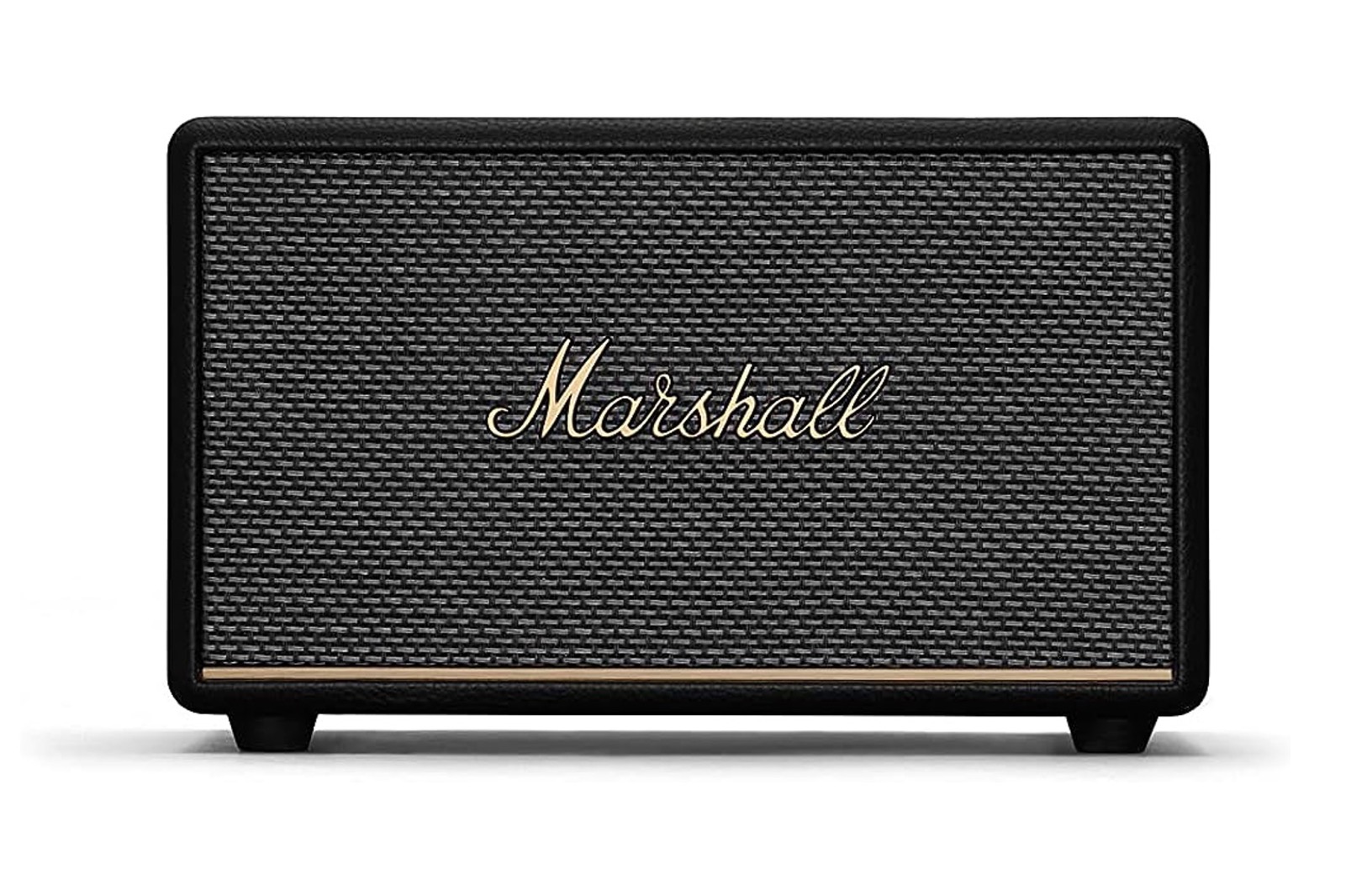
Specs
The Marshall Stanmore III is a louder and more powerful speaker as compared with the Acton III and delivers up to 80 watts RMS compared with the Acton III’s 60 W RMS. Both speakers are equipped with a single woofer and dual tweeters for stereo sound performance, and come with a bass-reflex port for enhanced bass performance. In terms of other specs, both the Stanmore III and Acton III are nearly identical, with both speakers having a frequency range from 45 Hz to 20 kHz and three Class D amplifiers. Both speakers also use the latest Bluetooth 5.2 codec for wireless music streaming and support 3.5mm auxiliary inputs.
With that said, one key difference between the Stanmore III and the Acton III is the size. The Acton 2 is clearly more compact and portable, and weighs much less (6.3 lbs) as compared to the Stanmore III’s 9.5 lbs. If you are looking for a speaker that can fit into a compact space on your desk or living room table, the Acton III is a better choice as the Stanmore III can feel somewhat large and bulky. The Stanmore III is more suited for larger spaces and adds a vintage feel to the overall interior space – although it is heavier and much larger than the Acton III.
Design
Both the Stanmore III and Acton III speakers look virtually identical and come with a top brass panel with analog controls. The brass control knobs allow you to adjust the volume, bass and treble ranges as well as manage track playback and volume settings; the speakers also have a power on/off toggle switch that looks really nice and vintage. Both speakers are also designed like stage amps with a really nice leatherette material covering the speaker, making it look great with any turntable setup. The Marshall Stanmore III and Acton III speakers also come with outward-angled tweeters that delivers a wider soundstage. You can read our full review of the Stanmore III speaker here.
The only difference between the Stanmore III and Acton III is the size – the Stanmore III is much larger and delivers louder sound performance, while the Acton III is designed to be more compact and can fit into smaller spaces in your home. Having said that, we did like the Acton III’s compact and portable design – it does not take up too much space and delivers sound performance on par with the Stanmore III in terms of audio clarity and loudness.
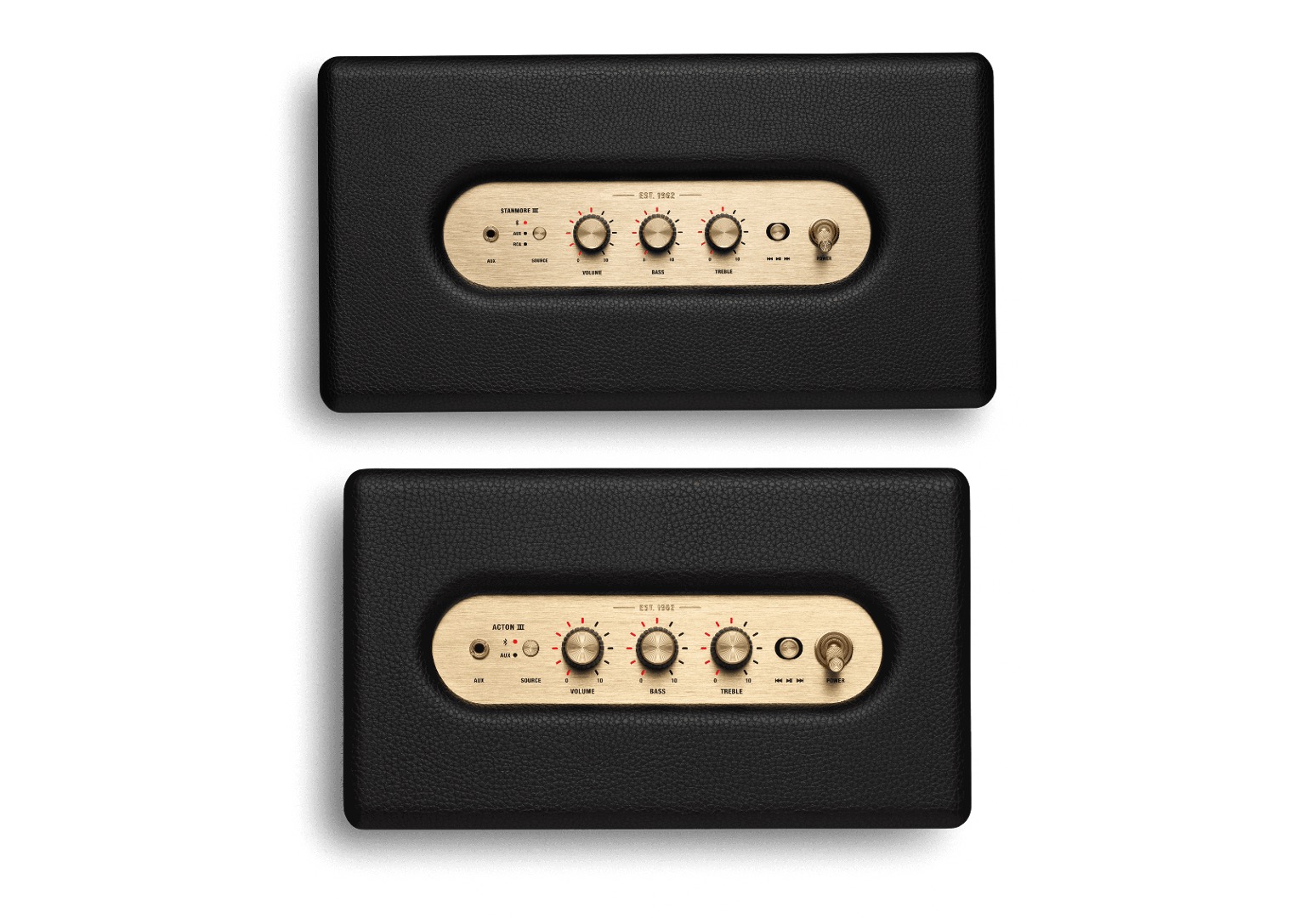
The Verdict?
The Marshall Stanmore III and Acton III are high-performance speakers that delivers really crisp highs, smooth midranges and good bass performance. We would say that the Stanmore III is more suited for those who want louder sound performance (up to 80W RMS) and deeper bass performance; the Acton III delivers a much more neutral sound signature and can bring out the details in instrumental and vocal performances. The Acton III also has the advantage of being more portable and compact, and is basically a smaller version of the Stanmore III but with the same sound quality and performance. Both speakers are great for music listening, and we would personally prefer the Stanmore III because it has much deeper bass and a warmer sound signature which makes it great for jazz and pop music genres. The Acton III however is better for those looking for a compact speaker to fit into the room with a really nice vintage design, and it provides essentially the same sound quality as the Stanmore III but with less bass and volume output.

